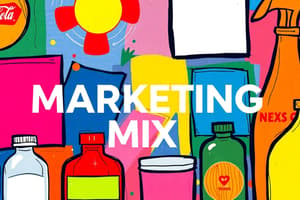Podcast
Questions and Answers
What is the primary focus of the business analysis stage in the new product development process?
What is the primary focus of the business analysis stage in the new product development process?
- Announcing the new product to the trade
- Evaluating alternative marketing strategies
- Assessing the likely demand for the product and its impact on sales and profits (correct)
- Developing a prototype of the product
During the development stage, which department is responsible for deciding on the product's packaging, branding, and labeling?
During the development stage, which department is responsible for deciding on the product's packaging, branding, and labeling?
- Production department
- Marketing department (correct)
- Engineering department
- R&D department
What is the primary benefit of simultaneous product development?
What is the primary benefit of simultaneous product development?
- Improving product quality
- Increasing market share
- Shortening the development process and reducing costs (correct)
- Reducing production costs
What is the primary purpose of test marketing?
What is the primary purpose of test marketing?
How long did McDonald's spend developing and testing salads before introducing them?
How long did McDonald's spend developing and testing salads before introducing them?
What is the final stage of the new product development process?
What is the final stage of the new product development process?
What is one of the tasks set in motion once the decision to commercialize a product is made?
What is one of the tasks set in motion once the decision to commercialize a product is made?
What is the primary goal of the business analysis stage in the new product development process?
What is the primary goal of the business analysis stage in the new product development process?
Which of the following is a benefit of simultaneous product development?
Which of the following is a benefit of simultaneous product development?
What is the primary purpose of test marketing, according to the content?
What is the primary purpose of test marketing, according to the content?
Flashcards are hidden until you start studying
Study Notes
Types of Consumer Products
- A product is everything a person receives in an exchange, including both favorable and unfavorable aspects.
- Products can be tangible (e.g. a pair of shoes) or intangible (e.g. a haircut).
Branding
- Branding is the main tool used to distinguish a product from competitors.
- A brand is a name, term, symbol, design, or combination that identifies a seller's products and differentiates them from others.
- A brand name is the part of a brand that can be spoken, including letters, words, and numbers.
- Brand marks are the non-spoken elements of a brand, such as symbols or logos.
Benefits of Branding
- Branding has three main purposes: product identification, repeat sales, and new product sales.
- Product identification allows marketers to distinguish their products from others.
- Repeat sales are generated through satisfied customers who identify products they wish to buy again.
- New product sales are facilitated through brand awareness and loyalty.
Branding Strategies
- Firms may choose to use manufacturers' brands, private (distributor) brands, or both.
- Manufacturers' brands are the brand names of manufacturers (e.g. Kodak).
- Private brands, also known as private labels or store brands, are owned by wholesalers or retailers (e.g. Tesco brand).
Trademarks
- A trademark is the exclusive right to use a brand or part of a brand.
- Trademarks can include shapes, colors, designs, phrases, abbreviations, and sounds.
Packaging
- Packaging has three main functions: containing and protecting products, promoting products, and facilitating storage, use, and convenience.
- A fourth function of packaging is to facilitate recycling and reduce environmental damage.
Packaging Functions
- Containing and protecting products: packaging enables manufacturers to market products in specific quantities and protects products from breakage, evaporation, and other conditions.
- Promoting products: packaging differentiates a product from competing products and associates a new product with a family of other products from the same manufacturer.
- Facilitating storage, use, and convenience: packaging innovations make products easier to handle, open, and reclose, and extend the product's shelf life.
Importance of New Products
- New products offer advantages such as increased sales, increased margins, increased product loyalty, more resale opportunities, greater market responsiveness, and a sustained leadership position.
New Product Development Process
- A new-product strategy links the new-product development process with the objectives of the marketing department, business unit, and corporation.
- The new-product development process includes idea generation, idea screening, business analysis, development, test marketing, and commercialization.
Idea Generation
- Sources of new-product ideas include customers, employees, distributors, vendors, competitors, R&D, and consultants.
Idea Screening
- The first filter in the product development process, which eliminates ideas that are inconsistent with the organization's new-product strategy or are obviously inappropriate.
Business Analysis
- Preliminary figures for demand, cost, sales, and profitability are calculated.
- Questions asked during this stage include: What is the likely demand for the product? What impact would the new product have on total sales, profits, market share, and return on investment?
Development
- The R&D or engineering department develops a prototype of the product.
- The marketing department decides on the product's packaging, branding, labeling, and so forth.
Test Marketing
- A limited introduction of a product and a marketing program to determine the reactions of potential customers in a market situation.
Commercialization
- The final stage of the new-product development process, which sets several tasks in motion, including production, inventory, shipping, sales force training, and advertising.
Studying That Suits You
Use AI to generate personalized quizzes and flashcards to suit your learning preferences.




